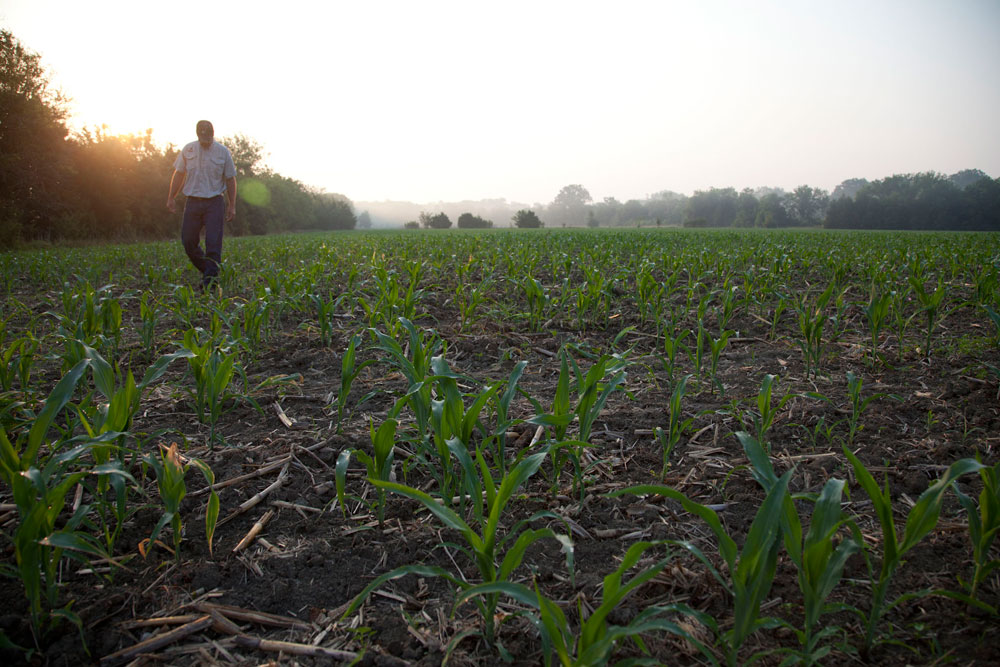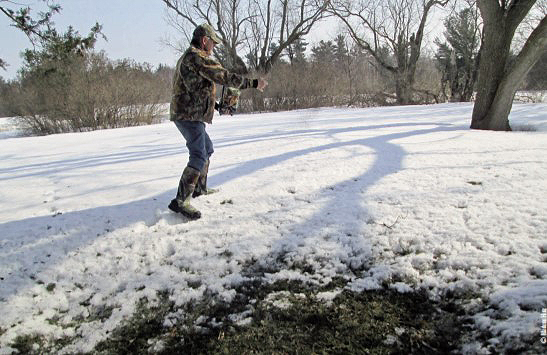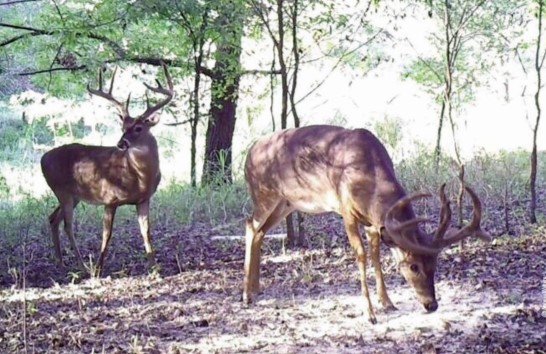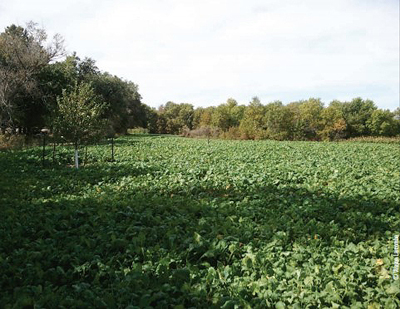Andrew Walters | Originally published in GameKeepers: Farming for Wildlife Magazine. To subscribe, click here.
As gamekeepers, most of us know more than your average hunter about wildlife habitat management. Just owning a piece of land or having access to hunt a tract isn’t enough. We are always looking for ways to increase our hunting and recreational experiences by means of land management. This ambition is what separates us from other outdoor enthusiasts. Hunting is only part of the payoff, the work and effort that goes into our land is a much larger piece of the puzzle.
A dilemma that many face is that they have a similar drive, but don’t have the time or resources necessary to manage their land themselves. In some cases hunters may be absentee landowners/managers. These are the managers who own land a fair distance from their homes and need to learn different ways to implement their management plans and how to maximize their time. These hunters are faced with more problematic situations than most. The question is, how can these, let’s call them “minimalist managers,” augment their hunting experiences and managing things with only a few visits to the property each year, or when they only have nominal funds, equipment or time?

Necessary Tools
There are many features to consider when deciding how to manage your land and a few tools are necessary in order to be successful. To begin, one must understand the current condition of the property and the wildlife. The most important items when beginning are aerial maps, a general knowledge of your property and most importantly a few trail cameras. It doesn’t hurt to have some knowledge of the surrounding area too. By using these tools you can determine the current status so you can work towards getting your property into shape.
Trail cameras are arguably the greatest tool for land managers to hit the wildlife management industry in the past thirty years. They are extremely important for the absentee landowner. Many hunters judge their management efforts by the caliber of the deer they harvest, when it should be judged by the deer regularly captured on camera.
Trail cameras are used to gauge the return of work invested and show proof that your management plan and efforts are paying off. The data retrieved from monitoring your herd will determine the direction your plans need to go to achieve the goals you have. Two of the major herd dynamics will be the age structure and sex ratio.
Cameras will also tell you when deer activity fluctuates. Then you can piece the puzzle together and determine what is causing the ebb and flow. Whitetails do things for a reason. Therefore it’s our goal to figure out why and either improve the situation, change the direction or capitalize on it.
Property owners who live hours from their property may choose to use trail camera systems that send photos via email or through text messages, basically scouting for you while you’re not there. The monthly or annual data or internet fees are well worth the information that will be provided from these devices.

An Over the Top Contribution
Knowing the basic characteristics and “lay of the land” of your property is also important. This may sound like a pretty mundane assumption, but it is critical to know the whereabouts of things that could benefit you during a hunt or from a management perspective. In other words, you should know about that small stand of oaks on the backside of your property that produce acorns early, the storm damage that happened on a certain ridge or the swampy area that beavers created this past spring. This knowledge can help with management decisions or when assessing hunting options.
How do you keep track of changes if you aren't around to monitor your land? This is where aerial maps and satellite images come into play. A view from above provides a different perspective and really shows your property in a different light. By looking at these maps you can see how close you are to landmarks such as food sources or water supplies, and if the maps are recent enough, even up to date disturbances such as fallen trees, fire damage or flooding may show up.
Depending on the style of map, even the types of forest cover can be identified. It is critical that you develop a strategy, both when hunting and with a management plan. Then even with limited time, by studying maps you can have an idea of the areas you want to concentrate on first or where you might find certain resources to help accelerate your efforts.
Howdy Neighbor
Another option for the absentee landowner is to understand what neighboring property owners are doing “management-wise” with their land. It will benefit you to talk with your neighbors or possibly a local tenant farmer to gather as much knowledge as possible. You can often find out how they do things and possibly learn about your herd and even maybe specific bucks.
The goal is to recognize what their property has to offer that yours may not. If your land is not very active during the early season and when talking to your neighbor you find out theirs is, you can bet they have something that you don’t. In this case you could either bolster your early season attraction or learn to use what your neighbor has to augment your efforts. This information can be used to provide improved habitat and produce better hunting if used properly. Now that we have some basic tools/needs covered, what should you do when you actually visit your land?

F+W+C+S (Food, Water, Cover & Sanctuary)
The habitat should be managed to produce the greatest amount of food and shelter as possible. This isn’t different than managing any other property, but a more strategic outlook is needed. The key is to figure out what can be easily modified that yields the greatest return and not to reinvent the wheel. Therefore if your property consists of 200 acres of agricultural and 40 of woods, it isn’t necessary to clear three acres of timber for a food plot. Since your time is limited, maybe the timber should instead be modified to increase horizontal diversity and bedding cover.
In many southern states the season opens during the late summer and early fall so many hunters set up stands over water sources. Water sources are a great addition to any property, but if a stream, river, or seasonal watering hole is already nearby, creating your own is not top priority and your time would be best spent elsewhere. Determine what your land is missing and then implement a strategy to correct it. Play to your strengths and bolster your weaknesses.
Absentee landowners may actually have to learn more and be versed in many different techniques. Since everything cannot be accomplished at the perfect time, tactics that most managers will never use like snow-seeding or frost seeding may be necessary. Learning to cut certain corners may also be wise. Whitetails, turkeys and other wildlife don’t need picture-perfect food plots; they just need them to produce food. It doesn’t need to be pretty, just effective.
For the landowner whose property has plenty of acreage for crops and food plots, but lacks forested bedding cover, a CRP (Conservation Reservation Program) plan, or something similar would work great. In this case the owner is swapping out a few acres of farmland to be used as bedding cover. These governmental programs allow landowners to plant certain types of vegetation on their property to provide security and forage. This type of management works well in the case of an absentee land manager because the CRP plans usually last for many years and require little maintenance.
Another positive to implementing a CRP plan is that it can be planted on any size property. It is not uncommon for farm fields between 10-30 acres to be planted in CRP. I shouldn’t have to tell you the effects of adding 30 acres of bedding cover to your property. There are many types of habitat management programs the NRCS (Natural Resources Conservation Service) can help you with and some vary by state so research them thoroughly and see what they have to offer in your location.

may be tough to achieve without babysitting the property. It
doesn’t have to be pretty, just effective.
On the other hand, some properties contain bleak monocultures of timber and lack substantial food sources. In this case a select timber harvest will thin out the tree canopy allowing more sunlight to penetrate to the forest floor. As a result, a thinned forest will produce tons of new vegetation.
Logging trails dissecting your property are great travel routes and can be planted with food plot seed. Also, selecting a few acres in a strategic location to be designated for a clear-cut would produce plenty of early succession vegetation and can provide enough cover to create a sanctuary.
Keep in mind that you should plant a mixture of food plots for various times of the year and some that would be desirable during the time you are capable of hunting. This sudden influx of forage may be just what your property needs to give you the edge. Also keep in mind that select timber harvest and governmental programs such as CRP will produce some sort of income. It’s tough to beat increasing your land’s productivity while getting a check in the mail for it.
You Need Help!
In some instances you may not be capable of determining or conducting many of the aforementioned tactics. You can contact a district biologist that works for your state, but unfortunately many state employed biologists are usually spread thin and have little time to spend on individual property projects. In this case you can hire a wildlife specialists or consultant.
While the titles of various experts vary, it is important to find someone who is qualified to create a management plan and can accurately interpret what is happening specifically on your land. Usually a wildlife specialist has a degree in a wildlife-related field and the background knowledge to identify what management modifications need to be implemented. By finding a professional who possess the knowhow to properly navigate the channels needed to design CRP plans and other management projects, you are saving yourself even more time and getting solid advice that will surely help you into the future.
While all gamekeepers would love to spend more time outdoors, living away from your property or keeping a busy schedule doesn’t mean you are at a disadvantage. If managed properly the absentee landowners may actually create a sanctuary because of the absence of pressure. Combine intensively managed land with a lack of hunting pressure and chances are the property is going to be a deer Mecca. Take a second to think about what your goals are for your property. It’s never too early to begin planning for next season. The most successful outdoorsmen are the ones who are always a step ahead and able to alter tactics based on changing information. Hopefully this will assist those gamekeepers who can’t spend a great deal of time on their ground and increase its efficiency for the few valuable days you get to spend there.































